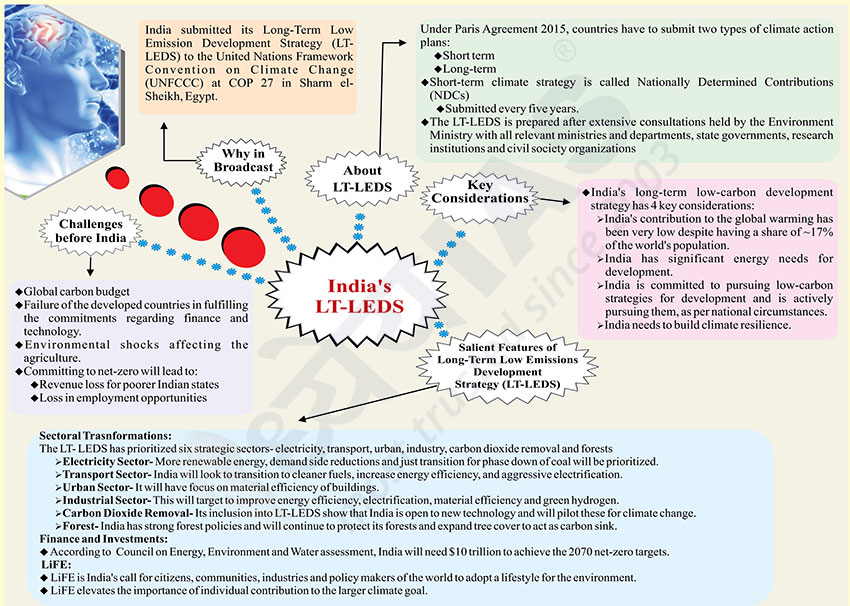Why in Broadcast?
- India submitted its Long-Term Low Emission Development Strategy (LTLEDS) to the United Nations Framework Convention on Climate Change (UNFCCC) at COP 27 in Sharm el-Sheikh, Egypt.
About LT-LEDS
- Under Paris Agreement 2015, countries have to submit two types of climate action plans:
- Short term
- Long-term
- Short-term climate strategy is called Nationally Determined Contributions (NDCs)
- Submitted every five years.
- The LT-LEDS is prepared after extensive consultations held by the Environment Ministry with all relevant ministries and departments, state governments, research institutions and civil society organizations
Key Considerations
- India's long-term low-carbon development strategy has 4 key considerations:
- India's contribution to the global warming has been very low despite having a share of ~17% of the world's population.
- India has significant energy needs for development.
- India is committed to pursuing low-carbon strategies for development and is actively pursuing them, as per national circumstances.
- India needs to build climate resilience.
Salient Features of Long-Term Low Emissions Development Strategy (LT-LEDS)
Sectoral Trasnformations:
The LT- LEDS has prioritized six strategic sectors- electricity, transport, urban, industry, carbon dioxide removal and forests
- Electricity Sector- More renewable energy, demand side reductions and just transition for phase down of coal will be prioritized.
- Transport Sector- India will look to transition to cleaner fuels, increase energy efficiency, and aggressive electrification.
- Urban Sector- It will have focus on material efficiency of buildings.
- Industrial Sector- This will target to improve energy efficiency, electrification, material efficiency and green hydrogen.
- Carbon Dioxide Removal- Its inclusion into LT-LEDS show that India is open to new technology and will pilot these for climate change.
- Forest- India has strong forest policies and will continue to protect its forests and expand tree cover to act as carbon sink.
Finance and Investments:
- According to Council on Energy, Environment and Water assessment, India will need $10 trillion to achieve the 2070 net-zero targets.
LiFE:
- LiFE is India's call for citizens, communities, industries and policy makers of the world to adopt a lifestyle for the environment.
- LiFE elevates the importance of individual contribution to the larger climate goal.
Challenges before India
- Global carbon budget
- Failure of the developed countries in fulfilling the commitments regarding finance and technology.
- Environmental shocks affecting the agriculture.
- Committing to net-zero will lead to:
- Revenue loss for poorer Indian states
- Loss in employment opportunities







